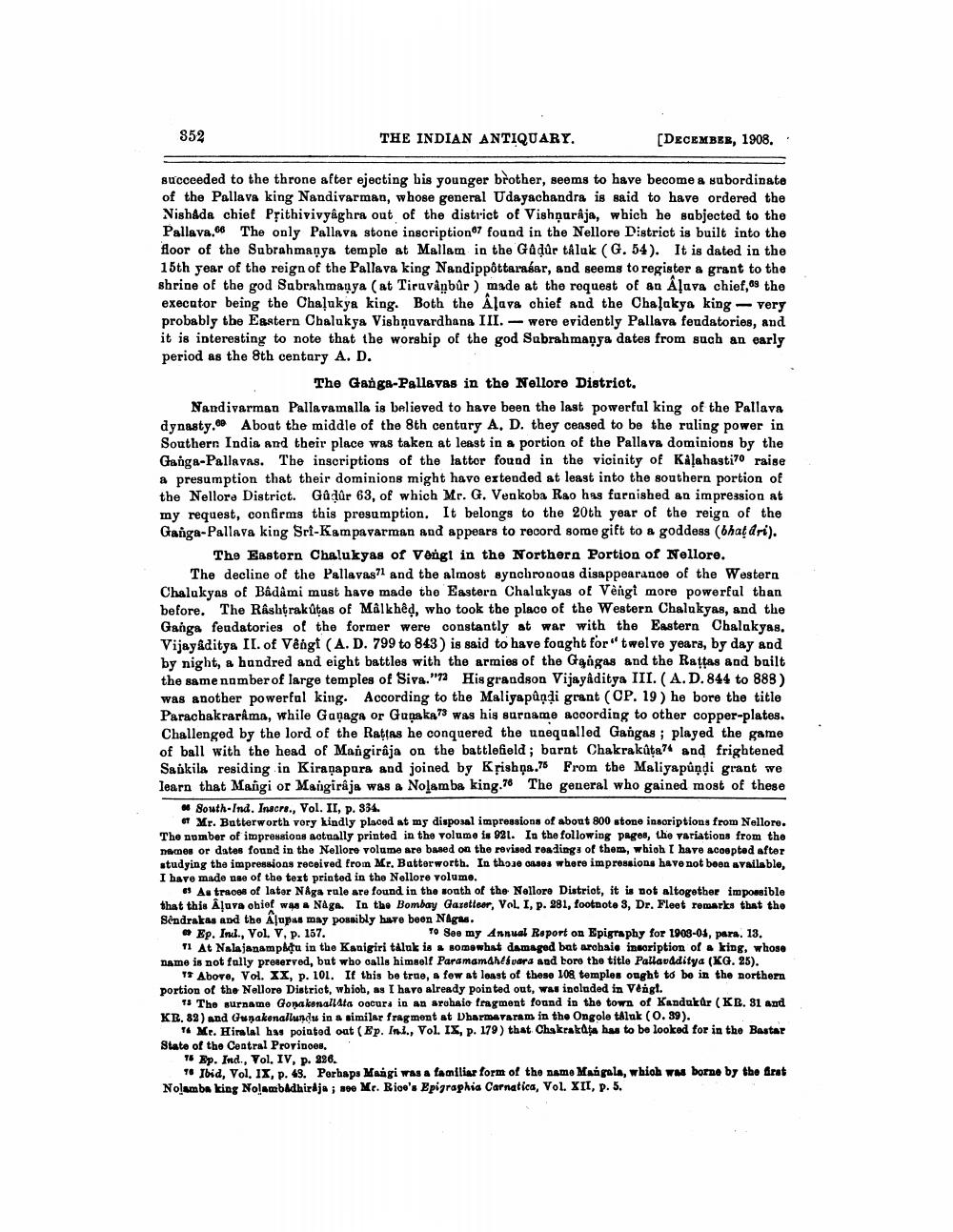________________
852
THE INDIAN ANTIQUARY.
[DECEMBER, 1908.:
succeeded to the throne after ejecting his younger brother, seems to have become a subordinate of the Pallava king Nandivarman, whose general Udayachandra is said to have ordered the Nishada chief Prithivivyâghra out of the district of Vishộurâja, which he sabjected to the Pallava. The only Pallava stone inscription7 found in the Nellore District is built into the floor of the Subrahmanya temple at Mallam in the Gâdûr taluk (G. 54). It is dated in the 15th year of the reign of the Pallava king Nandippóttarasar, and seems to register a grant to the shrine of the god Sabrahmanya (at Tiruvanbûr ) made at the roquest of an Âļava chief, 49 the executor being the Chalukya king. Both the Alava chief and the Chalakya king - very probably the Eastern Chalukya Vishnuvardhana III.-were evidently Pallava feudatories, and it is interesting to note that the worship of the god Sabrahmanya dates from such an early period as the 8th centary A. D.
The Ganga-Pallaves in the Nellore District, Nandivarman Pallavamalla is believed to have been the last powerful king of the Pallava dynasty.ce About the middle of the 8th centary A. D. they ceased to be the ruling power in Southern India and their place was taken at least in a portion of the Pallava dominions by the Ganga-Pallavns. The inscriptions of the lattor found in the vicinity of Kalahasti raise a presumption that their dominions might have extended at least into the southern portion of the Nellore District. Güqûr 63, of which Mr. G. Venkoba Rao has furnished an impression at my request, confirms this presumption. It belongs to the 20th year of the reign of the Ganga-Pallava king Sri-Kampavarman and appears to record some gift to a goddess (that dri).
The Eastern Chalukyas of Vengt in the Northern Portion of Nellore. The decline of the Pallavas7l and the almost synchronous disappearange of the Western Chalukyas of Bâdami must have made the Eastern Chalukyas of Vèngi more powerful than before. The Rashtrak utas of Malkhed, who took the place of the Western Chalukyas, and the Ganga feudatories of the former were constantly at war with the Eastern Chalukyas. Vijayaditya II. of Vengt (A.D. 799 to 843) is said to have fought for twelve years, by day and by night, a hundred and eight battles with the armies of the Gangas and the Rattas and built the same namber of large temples of Siva."72 His grandson Vijayaditya III. (A.D. 844 to 888) was another powerful king. According to the Maliyapůndi grant (CP. 19) he bore the title Paracbakraråma, while Gañaga or Gunaka 7 was his surname according to other copper-plates. Challenged by the lord of the Rattas he conquered the unequalled Gangas; played the game of ball with the head of Mangiraja on the battlefield; barnt Chakrakata74 and frightened Sankila residing in Kiraṇapara and joined by Krishņa.76 From the Maliyapundi grant we learn that Mangi or Mangiraja was a Nolamba king.78 The general who gained most of these
South-Ind. Inacra., Vol. II, p. 334. 6 Mr. Butterworth vory kindly placed at my disposal impressions of about 800 stone insoriptions from Nellore. The number of impressions actually printed in the volume is 921. In the following pages, the variations from the names or dates found in the Nellore volume are based on the revised
based on the revised readings of them, which I have acoepted after studying the impressions received from Mr, Batterworth. In the 04.393 where impressions have not been available, I have made use of the text printed in the Nellore volume.
6 As traces of later Någa rule are found in the south of the Nellore District, it is not altogether impossible that this Aļuva ohief was a Nage. In the Bombay Garetteor, Vol. I, p. 281, footnote 3, Dr. Fleet remarks that the Sendrakas and the Alupas may possibly have been Nagus. * Ep. Ind., Vol. V, p. 157.
TO See my Annual Report on Epigraphy for 1908-04, para. 13. T1 At Nalajanampatu in the Kanigiri taluk is & somewhat damaged bat arobaio insoription of a king, whose name is not fully preserved, but who calls himself Paramamah svara and boro the title Pallavdditya (KG. 25).
T1 Above, Vol. XX, p. 101. If this be true, a few at least of these 108 temples ought to be in the northern portion of the Nellore District, which, as I have already pointed out, was included in Vengt.
15 The surname Gonakenallata oscura in an arobaio fragment found in the town of Kandukur (KR. 81 and KR. 82) and Gunakenallundu in a similar fragment at Dharmavaram in the Ongole taluk (0.89).
* Mr. Hiralal ha pointed out (Ep. Ind., Vol. IX, p. 179) that Chakrakata has to be looked for in the Bastar State of the Central Provinces.
15 Ep. Ind., Vol. IV, p. 226.
16 Ibid, Vol. IX, p. 43. Porbaps Mangi was a familiar form of the name Mangala, which was borne by the Arat Nolamba king Nolambadhiraja , age Mr. Rige's Epigraphia Carnatica, Vol. XII, p. 5.




